greenDao数据库框架+Retrofit2框架+RxJava
添加所需要的相关依赖
作者:爱喝阔落的猫
在build.gradle中添加依赖
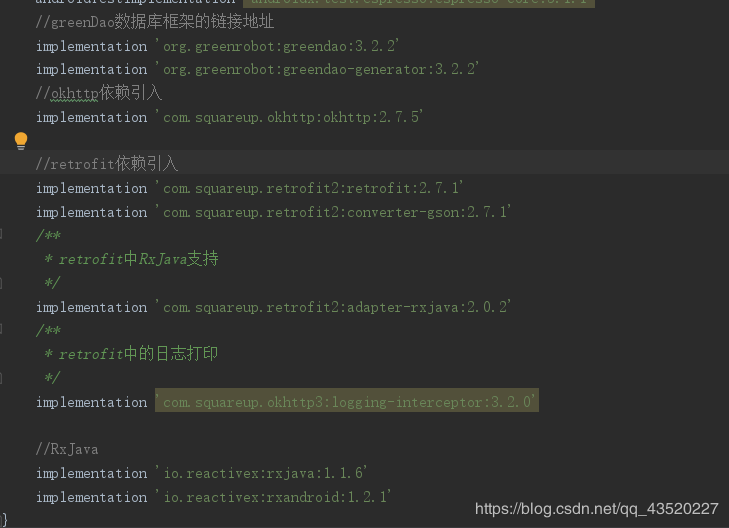
接着配置greenDao环境:
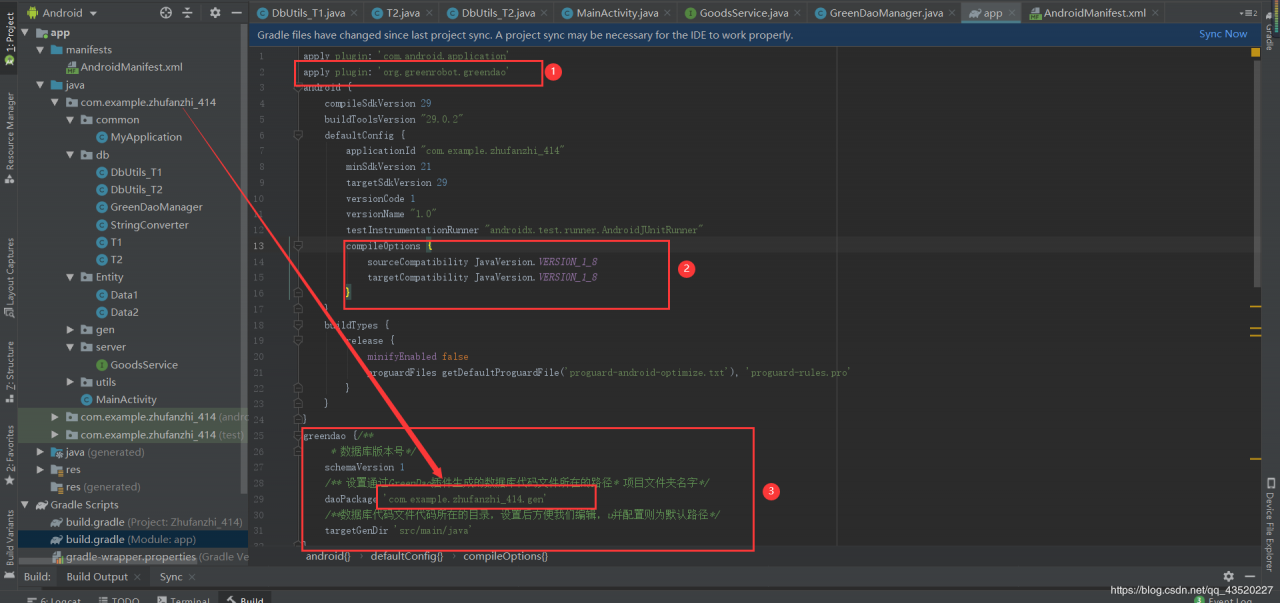
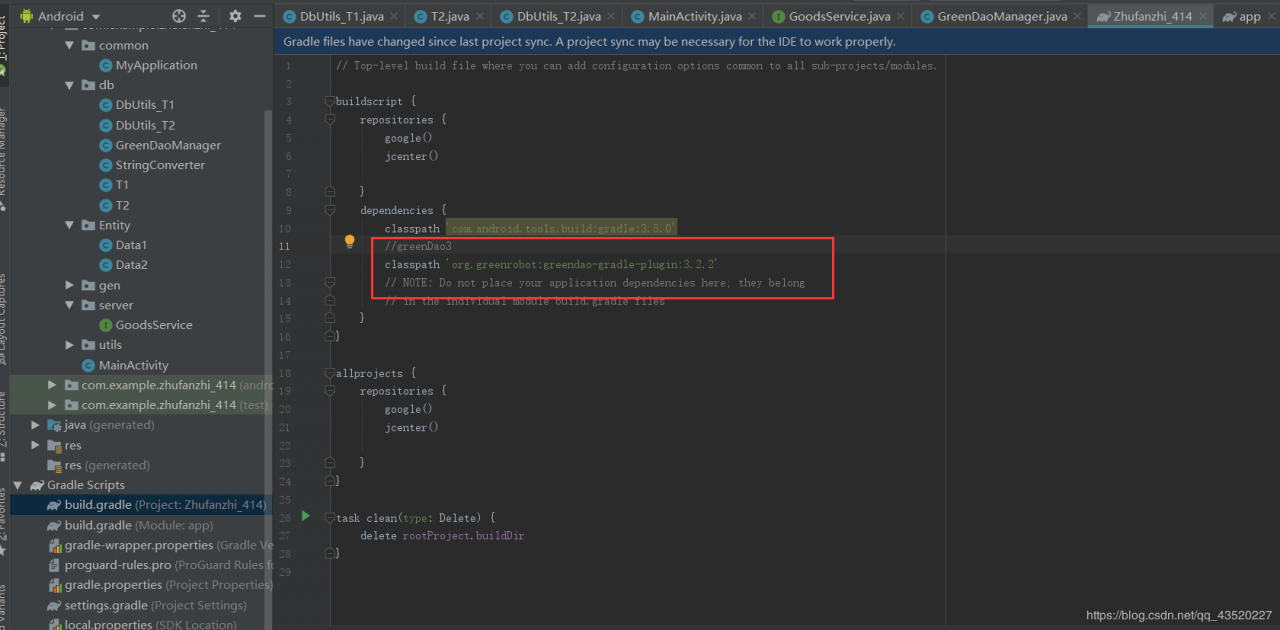
配置完我们就可以上代码了:
package com.example.zhufanzhi_414;
import androidx.appcompat.app.AppCompatActivity;
import retrofit2.Retrofit;
import retrofit2.adapter.rxjava.RxJavaCallAdapterFactory;
import retrofit2.converter.gson.GsonConverterFactory;
import rx.Observable;
import rx.Observer;
import rx.android.schedulers.AndroidSchedulers;
import rx.schedulers.Schedulers;
import android.os.Bundle;
import android.util.Log;
import com.example.zhufanzhi_414.Entity.Data1;
import com.example.zhufanzhi_414.Entity.Data2;
import com.example.zhufanzhi_414.db.DbUtils_T1;
import com.example.zhufanzhi_414.db.DbUtils_T2;
import com.example.zhufanzhi_414.db.T1;
import com.example.zhufanzhi_414.db.T2;
import com.example.zhufanzhi_414.server.GoodsService;
import com.example.zhufanzhi_414.utils.Constants;
import com.example.zhufanzhi_414.utils.Entity;
import java.util.ArrayList;
import java.util.List;
public class MainActivity extends AppCompatActivity {
@Override
protected void onCreate(Bundle savedInstanceState) {
super.onCreate( savedInstanceState );
setContentView( R.layout.activity_main );
testGetGoodsDetail();
}
private void testGetGoodsDetail() {
Retrofit retrofit = new Retrofit.Builder()
.baseUrl( Constants.BASE_URL1 )//设置访问网络地址
.addConverterFactory( GsonConverterFactory.create() )//设置解析方式为Gson
.addCallAdapterFactory( RxJavaCallAdapterFactory.create() )
.build();
GoodsService services = retrofit.create( GoodsService.class );
Observable observable = services.getkey( "admin", "123456" );//链接一
observable.subscribeOn( Schedulers.io() )
.observeOn( AndroidSchedulers.mainThread() )
.subscribe( new Observer() {
@Override
public void onCompleted() {
}
@Override
public void onError(Throwable e) {
}
@Override
public void onNext(Data1 data1) {
// Log.i( "获取数据1====>" ,"flag="+data1.isFlag());
// Log.i( "获取数据1====>" ,"apiUrl="+data1.getApiUrl());
// Log.i( "获取数据1====>" ,"aesKey="+data1.getAesKey());
// Log.i( "获取数据1====>" ,"user="+data1.getUser().toString());
// Log.i( "获取数据1====>" ,"cust="+data1.getCust());
// Log.i( "获取数据1====>" ,"errorMsg="+data1.getErrorMsg());
DbUtils_T1 db=new DbUtils_T1(MainActivity.this );
T1 t1=new T1( );
t1.setData1_aesKey(data1.getAesKey()+"");
t1.setData1_apiUrl(data1.getApiUrl()+"");
t1.setData1_flag(data1.isFlag());
t1.setData1_cust(data1.getCust()+"");
t1.setData1_errorMsg(data1.getErrorMsg()+"");
t1.setData1_user(data1.getUser().toString()+"");
db.insert( t1 );
db.selectAllDate();
}
} );
Observable observable1=services.get();//链接二
observable1.subscribeOn( Schedulers.io() )
.observeOn( AndroidSchedulers.mainThread() )
.subscribe( new Observer() {
@Override
public void onCompleted() {
}
@Override
public void onError(Throwable e) {
}
@Override
public void onNext(Data2 data2) {
// Log.i( "获取数据2====>", "flag=" + data2.isFlag() );
// Log.i( "获取数据2====>", "errorMsg=" + data2.getErrorMsg() );
//// Log.i( "获取数据====>" ,"list="+data2.getList().toString());
// for (int i = 0; i ", data2.getList().get( i ).getDes() );
//// Log.i( "获取数据2====>", data2.getList().get( i ).getLink_name() );
// }
DbUtils_T2 db=new DbUtils_T2(MainActivity.this );
for (int i =0;i<data2.getList().size();i++){
T2 t2=new T2(null,
data2.getList().get( i ).getDes()+"",
data2.getList().get( i ).getLink_tel()+"",
data2.getList().get( i ).getType_def()+"",
data2.getList().get( i ).getName()+"",
data2.getList().get( i ).getId(),
data2.getList().get( i ).getLink_name()+"",
data2.getList().get( i ).getNo_prefix()+""
);
db.insert( t2 );
}
db.selectAllDate();
}
} );
}
}
添加权限
所需要的注解以及接口公共类:
package com.example.zhufanzhi_414.server;
import rx.Observable;
import com.example.zhufanzhi_414.Entity.Data1;
import com.example.zhufanzhi_414.Entity.Data2;
import com.example.zhufanzhi_414.utils.Entity;
import java.util.Map;
import retrofit2.Call;
import retrofit2.http.Field;
import retrofit2.http.FieldMap;
import retrofit2.http.FormUrlEncoded;
import retrofit2.http.GET;
import retrofit2.http.POST;
import retrofit2.http.Query;
import retrofit2.http.QueryMap;
public interface GoodsService {
String getUrl = "filemgt/api/user/checklogin";
String postUrl = "filemgt/api/user/checklogin";
//链接一
@GET(getUrl)
Observable getkey(
/**
* 传递参数的Get请求
*/
@Query("username") String username,
@Query("password") String password
);
/**
* 封装好Url的Get的请求
*
* @return
*/
//链接二
// @GET(getUrl+"?key=488c65f3230c0280757b50686d1f1cd5&&sort=asc&&time=1418816972")
@GET("filemgt/api/basic/getCorpList")
Observable get();
/**
* 传递Map键值对的Get请求
**/
@GET(getUrl)
Call getmap(@QueryMap Map params);
/**传递参数的Post请求
*/
@FormUrlEncoded
@POST(postUrl)
Call postkey(@Field("key") String key, @Field("sort") String sort, @Field("time") String time);
/**
** 传递Map键值对的Post请求
*/
@FormUrlEncoded
@POST(postUrl)
Call postmap(@FieldMap Map map);//
}
接口:
package com.example.zhufanzhi_414.utils;
/**
* 常量数据类一般会放一些项目中公共的经常使用的数据。比如网络接口调用时的公共url;
*/
public class Constants {
//http://47.102.217.172:8088/filemgt/api/user/checklogin?username=admin&password=123456
public static String BASE_URL1="http://47.102.217.172:8088/";
}
接着我们还需要初始化greenDao
package com.example.zhufanzhi_414.common;
import android.app.Application;
import android.content.Context;
import com.example.zhufanzhi_414.db.GreenDaoManager;
public class MyApplication extends Application {
private static Context mContext;
@Override
public void onCreate() {
super.onCreate();
//初始化mContext
mContext=getApplicationContext();
//GreenDao全局初始化,只初始化一次防止多次初始化
GreenDaoManager.getInstance();
//全局化初始化Retrofit公共类
// HttpMethods.getInstance();
}
public static Context getContext(){
return mContext;
}
}
并在manifests中挂载
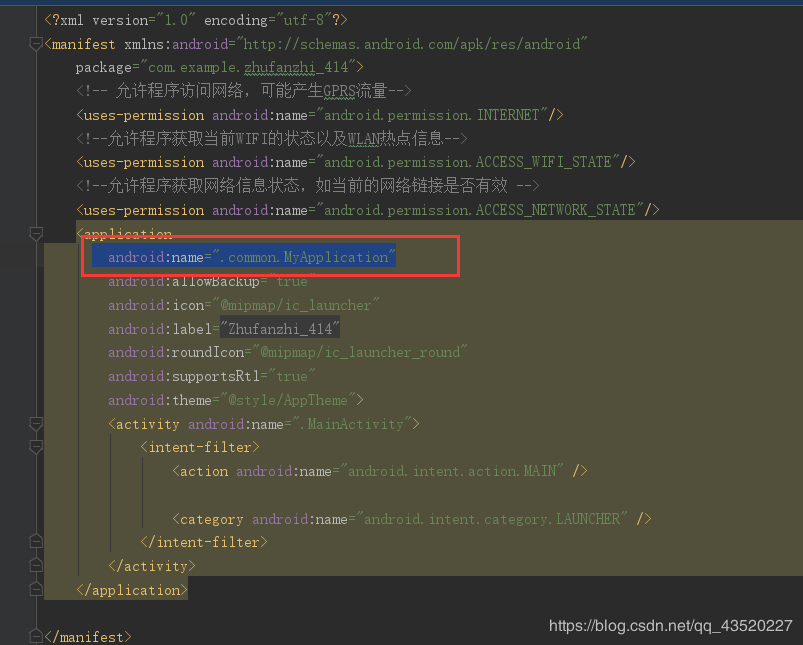
建立相应的数据表
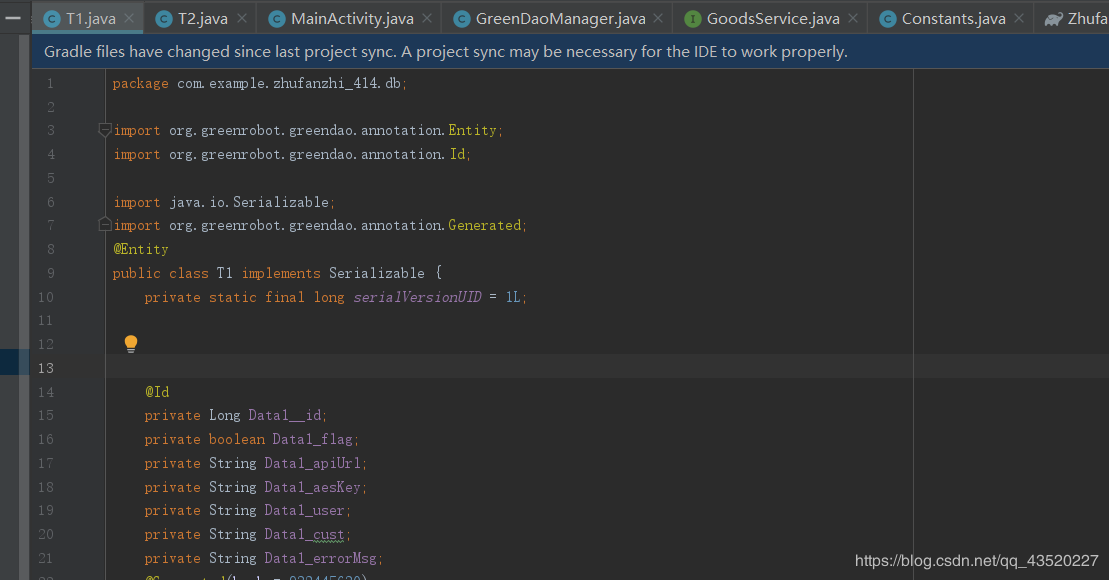
建立完表之后点击

就会生成相应的数据库Dao类文件了:
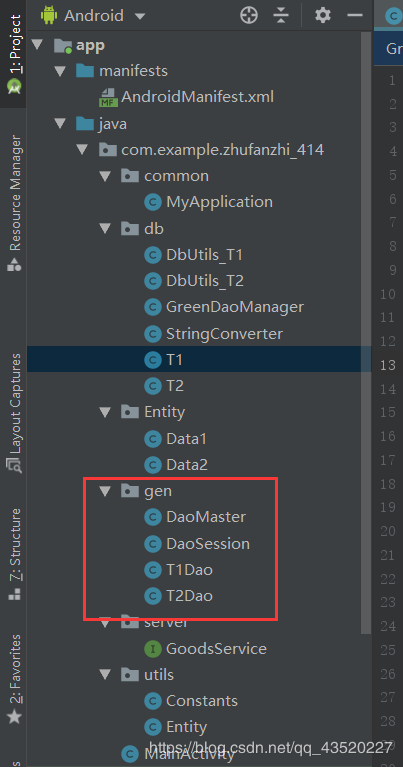
接着我们还需要数据库管理类
package com.example.zhufanzhi_414.db;
import com.example.zhufanzhi_414.common.MyApplication;
import com.example.zhufanzhi_414.gen.DaoMaster;
import com.example.zhufanzhi_414.gen.DaoSession;
public class GreenDaoManager {
private static GreenDaoManager mInstance;
private static DaoMaster mDaoMaster;
private static DaoSession mDaoSession;
public GreenDaoManager(){
if (mInstance==null){
/**
* 初始化并设置数据库名 MyApplication 全局类
*/
DaoMaster.DevOpenHelper devOpenHelper=new DaoMaster.DevOpenHelper( MyApplication.getContext(),"ZhuFanzhidb",null );
mDaoMaster=new DaoMaster( devOpenHelper.getWritableDatabase() );
mDaoSession=mDaoMaster.newSession();
}
}
public static GreenDaoManager getInstance(){
if (mInstance==null){
synchronized (GreenDaoManager.class){
if (mInstance==null){
mInstance=new GreenDaoManager();
}
}
}
return mInstance;
}
public static DaoMaster getMaster(){
return mDaoMaster;
}
public static DaoSession getSession(){
return mDaoSession;
}
public static DaoSession getNewSession(){
mDaoSession=mDaoMaster.newSession( );
return mDaoSession;
}
}
增加Dao类管理类:
package com.example.zhufanzhi_414.db;
import android.content.Context;
import android.util.Log;
import com.example.zhufanzhi_414.gen.T1Dao;
import java.util.List;
public class DbUtils_T1 {
private Context context;
private T1Dao t1Dao;
public DbUtils_T1(Context context){
this.context=context;
t1Dao=GreenDaoManager.getInstance().getSession().getT1Dao();
}
/**
*
* @param t1
*/
public void insert(T1 t1) {
t1Dao.getSession().insertOrReplace(t1);
}
/**
*
* @return
* 查询所有数据
*/
//查询所有数据
public List selectAllDate(){
List t1List = t1Dao.loadAll();
for (T1 t1 : t1List) {
Log.i("======", "===test1数据查询结果=====" + t1.toString());
}
return t1List;
}
//查询两条数据
// public List selectTwoDate(){
//
// //查询构建器
// QueryBuilder builder = categoryDao.getSession().queryBuilder( Category.class );
// List list = builder.where( CategoryDao.Properties.Sex.ge(1)).where( CategoryDao.Properties.Username.like("增加商品1")).list();
/**
* whereOr语句相当于select *from where name like ? or name = ? or age>?
* ge是 >= 、like 则是包含的意思
* whereOr是或的意思,比如下面的whereOr的意思就是age>=22||name 包含 张三
* where则是age>=22 && name 包含 张三
*greenDao除了ge和like操作之外还有很多其他方法
* eq == 、 noteq != 、 gt > 、lt < 、le <= 、between 俩者之间
* in 在某个值内 、notIn 不在某个值内
*/
// List list=builder.where( CategoryDao.Properties.Marjectkey.le( 2 )).list();
// for (Category cate:list){
// Log.i( "读出两条数据",cate.toString());
// }
// return list;
//
//
// }
/**
* 根据自增id来查询
* @param id
* @return
*/
public T1 selectByID(Long id){
return t1Dao.load( id );
}
/**
* 删除指定ID数据
* @param id
*/
public void deleteDataByID(Long id){
t1Dao.deleteByKey( id );
}
/**
* 数据库数据更新
* 注意:我们以前操作数据库更新时,都是根据SQL语言,指定更新对应字段,这边由于使用GreenDao框架,会
* 帮我们检索长传的对应类哪些字段的改变进行更新
* @param t1
*/
public void update(T1 t1){
t1Dao.update( t1 );
}
}
完整代码就是以上了。此博客仅用于自己每天学习
最后,感谢阅读,卖个萌o(∩_∩)o 哈哈!
作者:爱喝阔落的猫